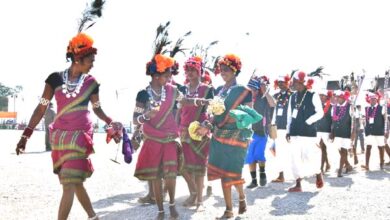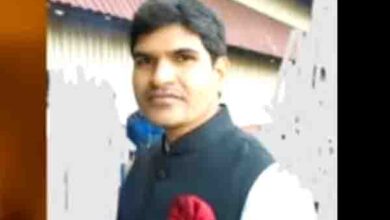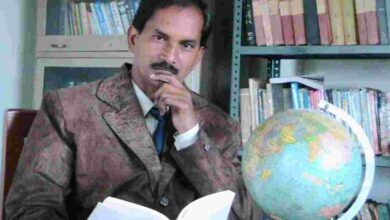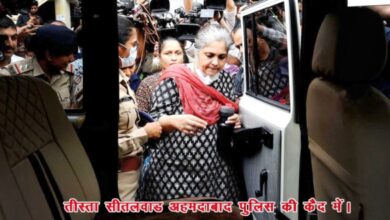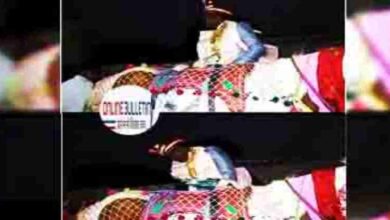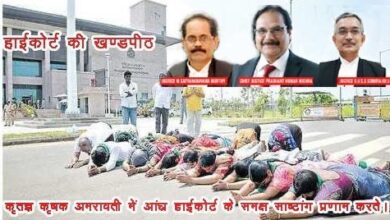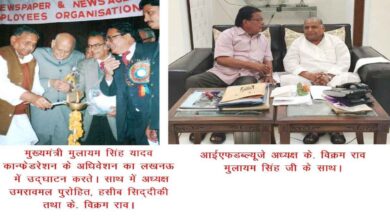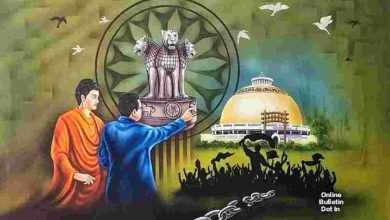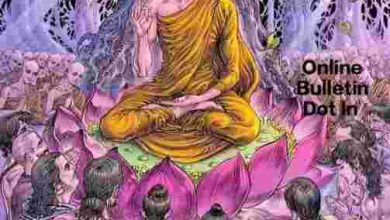”नेशनल हेरल्ड” : क्या गत बन गयी आज ! भाग- एक neshanal herald : kya gat ban gayee aaj ! bhaag- ek

©के. विक्रम राव, नई दिल्ली
–लेखक इंडियन फेडरेशन ऑफ वर्किंग जर्नलिस्ट (IFWJ) के राष्ट्रीय अध्यक्ष हैं।
”नेशनल हेरल्ड” कभी आजादी की आवाज था। अब संस्थापक जवाहरलाल नेहरु के पडनाती राहुल गांधी ने उसे फिर जगविख्यात करा दिया। कारण नीक नहीं है, हेय है। इस प्रतिक्षारत प्रधानमंत्री को केन्द्रीय प्रवर्तन निदेशालय ने फर्जीवाडा और धनशोधन अर्थात कोष के लूट का आरोपी करार दिया। खैर जुर्म पर निर्णय तो दिल्ली उच्च न्यायालय देगा। मगर हेरल्ड तब और अब पर गौर करना चाहिये। इतिहास बोध का यह तकाजा है। मेरा एक दस्तावेजी लेख (15 नवम्बर 1998) का पेश है। तस्वीर का खाका पूरा रेखांकित करता है। साभार दैनिक राष्ट्रीय सहारा, लखनऊ—दिल्ली :
आजादी की आवाज था हेरल्ड खो गया इतिहास में।”
अंग्रेज नेशनल हेरल्ड को बंद कराना चाहते थे। कांग्रेसियों ने उसे नीलामी पर चढ़ा दिया। ठीक (1938) में कैसरबाग चौराहे (लखनऊ) की पासवाली इमारत पर जवाहर लाल नेहरू ने तिरंगा फहरा कर राष्ट्रीय कांग्रेस के इस दैनिक को शुरू किया था। आज उनके नवासे की पत्नी ने नेहरू परिवार की इस सम्पत्ति की सरेआम बोली तहसीलदार सदर ने लगवा दी, ताकि चार सौ कार्मिकों के बाइस माह के बकाया वेतन में चार करोड़ रूपये वसूले जा सकें।
यूपी प्रेस क्लब में उन दिनों अटल बिहारी वाजपेयी ने संवाददाताओं के पूछने पर कहा था- जो हेराल्ड नहीं चला पाये, वे देश क्या चला पायेंगे? टिप्पणी सटीक थी, सच हो सकती है। देश की जंगे आजादी को भूगोल का आकार देने वाला हेराल्ड फिर खुद भूगोल से इतिहास में चला गया।
लेखक टामस कार्लाइल की राय में अखबार इतिहास का अर्क होता है। अर्क के साथ हेरल्ड एक ऊर्जा भी था अब दोनों नहीं बचे। जब इसके संस्थापक-संपादक मेरे स्वर्गीय पिता श्री के. रामा राव ने मई 1938 में प्रथम अंक निकाला था, तभी स्पष्ट कर दिया था कि लंगर उठाया है तूफान का सर देखने के लिए। बहुतेरे तूफान उठे, पर हेरल्ड की कश्ती सफर तय करती रही। जब यदि डूबी भी तो किनारे से टकराकर। इसकी हस्ती ब्रिटिश राज के वक्त भी बनी रही, भले ही दौरे-जमाना उसका दुश्मन था? नेहरू और रफी अहमद किदवई इसके खेवनहार थे।
इसपर कई विपत्तियां आई मगर यह टिका रहा। एक घटना है 1941 के नवम्बर की जब अमीनाबाद के व्यापारी भोलानाथ ने कागज देने से मना कर दिया था क्योंकि उधार काफी हो गया था। नेहरू ने तब एक रूक्के पर दस्तखत कर हेरल्ड को बचाया था, हालांकि नेहरू ने व्यथा से कहा भी कि ”सारे जीवन भर मैं ऐसा प्रामिसरी नोट न लिखता।”
पिता की भांति पुत्री ने भी हेरल्ड को बचाने के लिए गायिका एम.एस. सुब्बालक्ष्मी का कार्यक्रम रचा था, ताकि धनराशि जमा हो सके। इंदिरा गांधी तब कांग्रेस अध्यक्ष थी। रफी अहमद किदवई और चन्द्रभानु गुप्त ने आपसी दुश्मनी के बावजूद हेरल्ड राहत के कूपन बेचकर आर्थिक मदद की थी।
हेरल्ड ने आज़ाद भारत के समाचारपत्र उद्योग में क्रांति की थी जब 1952 में सम्पादक की अध्यक्षता में सहकारी समिति बनाकर प्रबंध चलाया गया था। तब प्रधानमंत्री नेहरू ने प्रबन्ध निदेशक मोहनलाल सक्सेना (22 अप्रैल 1952) को लिखे पत्र में इस अभिनव श्रमिक प्रयोग की सफलता की कामना की थी। उमाशंकर दीक्षित जो कुशल प्रबंध निदेशक बनकर आये, ने कश्ती बचा ली।
प्रधानमंत्री के तीन मूर्ति आवास में 1957 में निदेशकों की बैठक में दीक्षित की नियुक्ति की गयी। हेरल्ड और उसके साथी दैनिक ‘नवजीवन’ और ‘कौमी आवाज’ की प्रतियां बढ़ीं। विज्ञापनों का अम्बार लग गया। मुनाफा तेजी से बढ़ा। उमाशंकर दीक्षित बाद में इंदिरा गांधी के गृह मंत्री बने, फिर बंगाल के राज्यपाल। इन्हीं की पतोहू श्रीमती शीला दीक्षित दिल्ली में मुख्यमंत्री पद पर रही।
श्रमिक सहयोग का यह नायाब उदाहरण हेरल्ड में एक परिपाटी के तहत सृर्जित हुआ था। दौर था द्वितीय विश्वयुद्ध का। छपाई के खर्चे और कागज के दाम बढ़ गये थे। हेरल्ड तीन साल के अन्दर ही बंदी की कगार पर था। अंग्रेजपरस्त दैनिक ‘पायनियर’ इस आस में था कि उसका एक छत्र राज कायम हो जायेगा। तब पत्रकारों और अन्य कर्मियों ने स्वेच्छा से अपना वेतन आधा करवा लिया था।
तीन महीने तो बिना वेतन के काम किया। कई अविवाहित कर्मचारी हेरल्ड परिसर में रहते और सोते थे। कामन किचन भी चलता था जहां चंदे से खाना पकता था। संपादक के हम कुटम्बीजन तब (आठ भाई-बहन) माता-पिता के साथ नजरबाग के तीन मंजिला मकान में रहते थे। किराया था तीस रूपये हर माह। तभी अचानक एक दिन पिता जी हम सबको दयानिधान पार्क (लालबाग) के सामने वाली गोपालकृष्ण लेन के छोटे से मकाने में ले आये। किराया था सत्रह रूपये।
दूध में कटौती की गयी। रोटी ही बनती थी क्योंकि गेहूं रूपये में 10 सेर था और चावल बहुत महंगा था, रूपये में सिर्फ 6 सेर मिलता था। दक्षिण भारतीयों की पसन्द चावल है। फिर भी लोभ संवरण कर हमें गेहूं खाना पड़ा। यह सारी बचत, कटौती, कमी बस इसलिए कि हेरल्ड छपता रहे। यह परिपाटी हेरल्ड के श्रमिकों को सदैव उत्प्रेरित करती रही, हर उत्सर्ग के लिए।
part 1 of 3
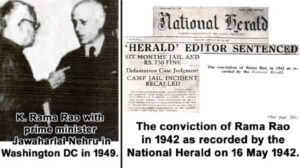
“National Herald”: What has become today! part One
The “National Herald” was once the voice of freedom. Now Rahul Gandhi, the grandnephew of the founder Jawaharlal Nehru, made him world famous again. The reason is not good, it is hey. This waiting prime minister was accused by the Central Enforcement Directorate for forgery and money laundering i.e. looting of funds. Well, the decision on the crime will be given by the Delhi High Court. But the Herald then and now should be looked into. This is a testament to the understanding of history. I present a documentary article (15 November 1998). Outlines the full outline of the picture. Courtesy Dainik Rashtriya Sahara, Lucknow-Delhi:
The voice of freedom was the herald lost in history.
The British wanted to close down the National Herald. Congressmen put him on auction. It was in 1938 that the National Congress daily was started by Jawaharlal Nehru by hoisting the tricolor on the building near Kaiserbagh Square (Lucknow). Today, the wife of his grandson got this property of Nehru family publicly auctioned by Tehsildar Sadar, so that four crore rupees could be recovered from the salary of twenty two months of 400 employees.
In those days, Atal Bihari Vajpayee had said in the UP Press Club when asked by the reporters – Those who could not run the Herald, what would they be able to run the country? The comment was accurate, may be true. The Herald, who shaped the country’s war independence into geography, again went from geography to history.
In the opinion of author Thomas Carlyle, the newspaper is an extract of history. Harald was also an energy with Ark, now both are no more. When its founder-editor, my late father Shri K. Rama Rao brought out the first issue in May 1938, only then made it clear that he had raised the langar to see the head of the storm. Many storms arose, but Harald’s kayak continued to travel. Even if it sank, it collided with the shore. Its reputation continued even during the British Raj, even though travel was its enemy. Nehru and Rafi Ahmed Kidwai were its architects.
It faced many calamities but it lasted. There is an incident in November of 1941 when Bholanath, a businessman from Aminabad, refused to give the paper because the loan had become enough. Nehru then saved the herald by signing a rookah, although Nehru said with anguish that “all my life I would not write such a promissory note”.
Like the father, the daughter also joined the singer M.S. to save Harald. Subbalakshmi’s program was made so that the money could be deposited. Indira Gandhi was then the Congress President. Rafi Ahmed Kidwai and Chandrabhanu Gupta had helped financially by selling coupons of Herald relief despite mutual enmity.
The Herald revolutionized the newspaper industry of independent India when in 1952, under the chairmanship of the editor, the management was run by forming a cooperative society. Then Prime Minister Nehru in a letter to the Managing Director Mohanlal Saxena (22 April 1952) had wished for the success of this innovative labor experiment. Umashankar Dixit, who came as an efficient managing director, saved the kayak.
Dixit was appointed in the meeting of directors in 1957 at the Teen Murti residence of the Prime Minister. Copies of the Harald and its fellow dailies ‘Navjeevan’ and ‘Qaumi Awaaz’ grew. Advertisements piled up. Profits grew rapidly. Umashankar Dixit later became the Home Minister of Indira Gandhi, then the Governor of Bengal. His brother-in-law, Mrs. Sheila Dikshit, remained as the Chief Minister in Delhi.
This unique example of labor cooperation was created in the Herald under a convention. It was the period of World War II. Printing costs and paper prices had gone up. Harald was on the verge of captivity within three years. The British daily ‘Pioneer’ was in the hope that an umbrella rule would be established. Then the journalists and other workers voluntarily got their salaries cut in half.
Worked for three months without pay. Many unmarried employees lived and slept on the Herald premises. There was also a common kitchen where food was cooked from donations. Editor’s Hum Kutumbijan then (eight siblings) lived with parents in a three-storey house in Nazarbagh. The rent was thirty rupees per month. Then suddenly one day father brought all of us to a small house on Gopalkrishna Lane in front of Dayanidhan Park (Lalbagh). The rent was seventeen rupees.
Milk was cut. Roti was made only because wheat was 10 ser in rupees and rice was very expensive, only 6 ser was available in rupees. Rice is the favorite of South Indians. Still, we had to eat wheat out of greed. All these savings, deductions, shortfalls just because the Herald keeps on printing. This practice always inspired the workers of the Herald, for every release.
part 1 of 3


